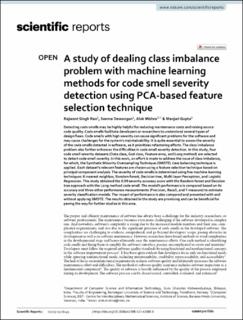| dc.description.abstract | Detecting code smells may be highly helpful for reducing maintenance costs and raising source code quality. Code smells facilitate developers or researchers to understand several types of design flaws. Code smells with high severity can cause significant problems for the software and may cause challenges for the system's maintainability. It is quite essential to assess the severity of the code smells detected in software, as it prioritizes refactoring efforts. The class imbalance problem also further enhances the difficulties in code smell severity detection. In this study, four code smell severity datasets (Data class, God class, Feature envy, and Long method) are selected to detect code smell severity. In this work, an effort is made to address the issue of class imbalance, for which, the Synthetic Minority Oversampling Technique (SMOTE) class balancing technique is applied. Each dataset's relevant features are chosen using a feature selection technique based on principal component analysis. The severity of code smells is determined using five machine learning techniques: K-nearest neighbor, Random forest, Decision tree, Multi-layer Perceptron, and Logistic Regression. This study obtained the 0.99 severity accuracy score with the Random forest and Decision tree approach with the Long method code smell. The model's performance is compared based on its accuracy and three other performance measurements (Precision, Recall, and F-measure) to estimate severity classification models. The impact of performance is also compared and presented with and without applying SMOTE. The results obtained in the study are promising and can be beneficial for paving the way for further studies in this area. | en_US |

